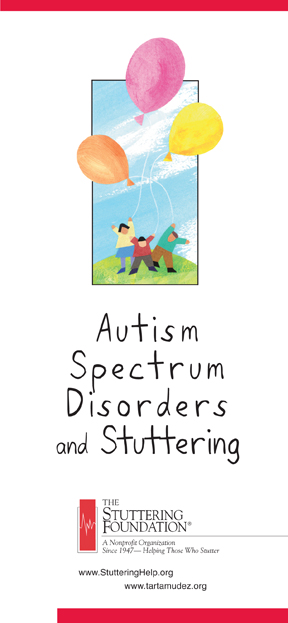 Autism Spectrum Disorders and Stuttering Brochure
Autism Spectrum Disorders and Stuttering Brochure
Tips for parents
If your child is stuttering, treat him as you would any other child: with kindness and respect. Above all, convey total acceptance. Working on communication and fluency skills is a challenge that affects all areas of a child's day; therefore, the child needs as much support, encouragement and acceptance as possible. When he is speaking, try to focus on the following:
• Listen to what your child has to say. Use facial expressions and other body language to convey that you are listening to the content of the message and not to how your child is talking. Maintain eye contact.
• Allow your child the time he needs to finish his thoughts.
• Help all members of the family learn to take turns talking and listening. Objects such a microphone or a salt shaker at the dinner table can be passed to indicate each person’s turn. This provides a good model for the child with an ASD and helps her to feel like your family is “in this together.”
• Choose specific and brief times to work on strategies in the midst of everyday activities, such as 5-10 minutes during bath time. Short consistent practice is often most effective.
Tips for therapists in structuring sessions
Structure activities according to a consistent, organized schedule that the young person has helped to create. Post these routines in the therapy room so he is aware of the schedule and what comes next. The ASD population benefits most from direct engagement; this is contrary to the ADHD population who respond to rewards.
Therefore, you should teach and practice tools in the context of play or preferred activities to keep the young person engaged, and to make activities meaningful. If activities are meaningful, she will remember and use them outside therapy. Research indicates if children with ASDs are not first engaged, all the rewards in the world will not lead to generalization. Therefore, engagement is key.
For example, if the child is engaged and motivated to have a snack, have her practice speech tools when asking for the snack.
• Keep instructions simple, clear, and concise. Be sure that the child is engaged with you, and present directions multiple times if necessary. If there is no response, try simplifying the directions and/or adding visual/contextual cues. For example, simplify “Get your coat so we can go outside” to “Going outside. Get coat” while pointing to the child’s coat.
• Provide visual cues, concrete examples and drawings to increase comprehension. For example, try stretching Playdough while practicing easing in to a speech sound “e e e a s y.”
• Increase the child’s self-monitoring skills and awareness of how behaviors affect interactions with others. Focus on the accuracy of self-assessment of his speech in simple and complex speaking situations. Then teach problem solving to allow him to change his speech accordingly.
• Keep in mind the child’s level of functioning: some are quite literal and need more concrete examples, such as rating their use of speech tools “thumbs up” or “thumbs down,” while others can use more cognitively-based rating systems, such as using a scale from 1-5.
• Address overall communication skills. By introducing and modeling appropriate skills such as eye contact, volume, rate, and listening skills yourself, you will help to increase the child’s confidence and self-esteem while reducing speech-related anxiety.
• Young people with ASDs benefit from working with socially stronger peers who can act as role models. To foster generalization of new skills, explore grouping the individual with others who have similar speech characteristics and who are good social models. This will provide an optimal setting to practice fluency tools, social skills, and overall self-monitoring.






 Podcast
Podcast Sign Up
Sign Up Virtual Learning
Virtual Learning Online CEUs
Online CEUs Streaming Video Library
Streaming Video Library